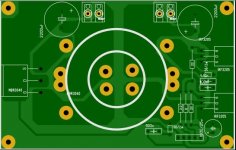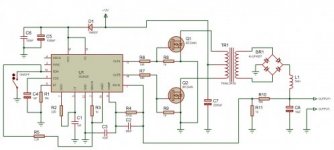I am trying to build a 12volt to 5volt 30 ampere dc-dc smps.
I have used Sg3525 as switching IC and IRF3205 mosfets and MBR3040 output diode. Switching output is around 55khz.
When I test the circuit at minimum load output unable to sink full current , the ouput voltage drops down to 3.5 volt at .25 ohms resistive load.
Below is the mainboard PCB which I used. Torroid is 44 mm dia ferrite core with 5 turns primary 3x1mm wire and 2 turns secondary 4x1mm wire.
Please advice why voltage drops considerably at low resistance and how I can achieve 30 ampere at 5volt with this pcb.
I have used Sg3525 as switching IC and IRF3205 mosfets and MBR3040 output diode. Switching output is around 55khz.
When I test the circuit at minimum load output unable to sink full current , the ouput voltage drops down to 3.5 volt at .25 ohms resistive load.
Below is the mainboard PCB which I used. Torroid is 44 mm dia ferrite core with 5 turns primary 3x1mm wire and 2 turns secondary 4x1mm wire.
Please advice why voltage drops considerably at low resistance and how I can achieve 30 ampere at 5volt with this pcb.
Attachments
Last edited:





